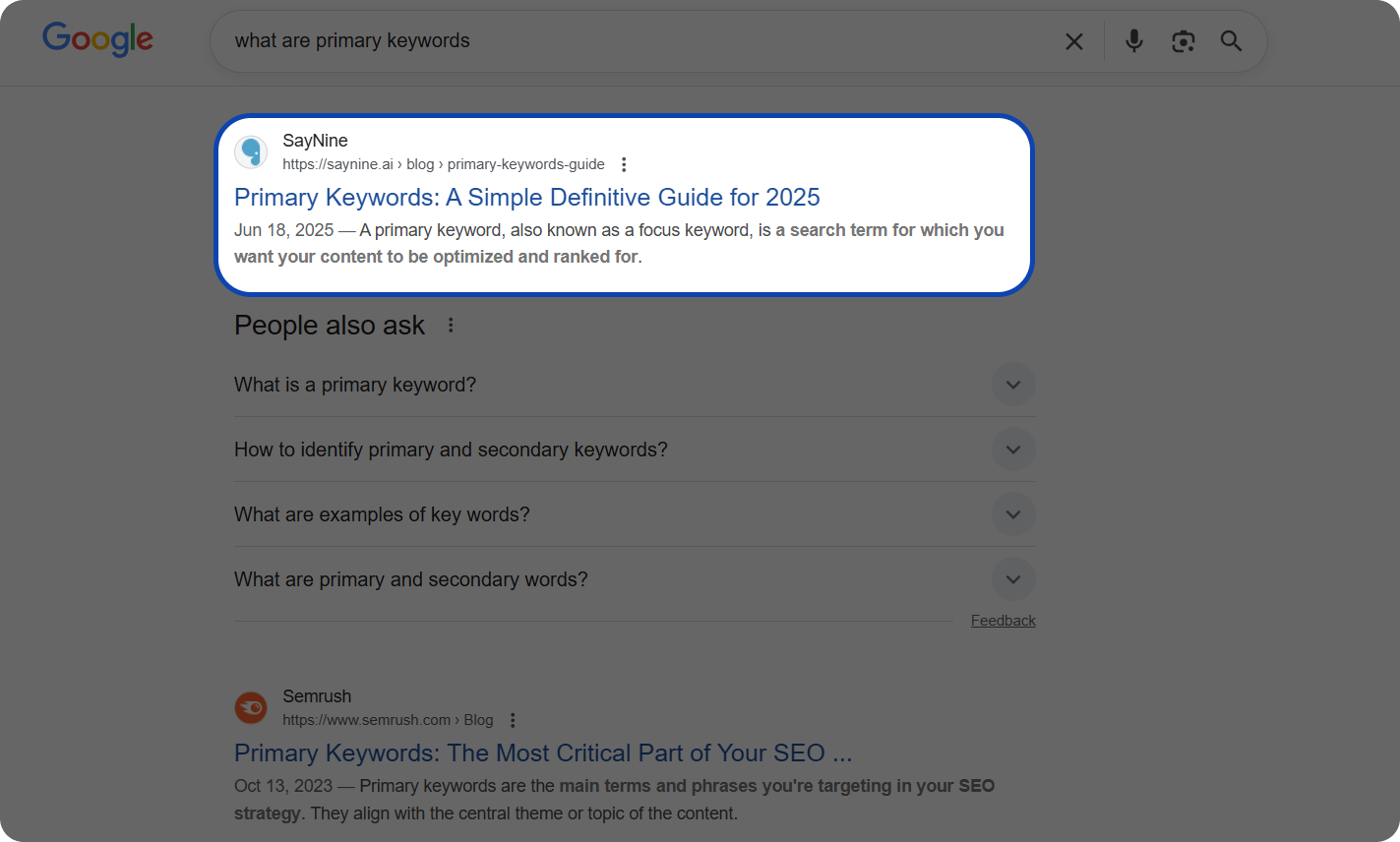If you write SEO content, search intent should be your best friend.
It tells you what people actually want when they type something into Google, and it saves you from giving them a sales pitch when all they wanted was a simple answer.
Get the intent wrong, and your reader bounces. Get it right, and they stick around, learn something useful, and might even become a customer.
In this guide, you will learn what search intent really is, how to check and use it to create content that feels right for your audience.
What is Search Intent?
Search intent shows a user’s real goal or purpose when they search for something in a search engine.
For example, someone searching for “What is SEO” probably looks for beginner-friendly information that’s easy to understand. Give the readers everything they came for, and you win their trust.
We gave an example of informational intent, but there are a few other types, too, which we’ll get into in a bit.
4 Main Types of Search Intent
Navigational Search Intent
Navigational intent is used when users are looking for a specific website or web page (e.g., Facebook login).
So, make sure your website is easy to find, page speed is fine, and it works smoothly to avoid any user frustration.
Informational Search Intent
Informational intent is used when a user is searching for certain information, answers, and wants to learn about something. These searches could be about anything, from astrology to science and digital marketing.
For example, I searched “what are primary keywords,” and here are what results I got.
Not to brag, but it looks like we’re actually ranking first in the search results! 🤭

Commercial Search Intent
Ever wanted to buy something but could not understand which option fits your needs the best?
Of course you have, but making a purchase is rarely as simple as it sounds. Even the most dedicated shopaholics will admit it!
Users who are searching for “best cars in 2025,” for example, have the intention to buy a car and use the web to get more information on different models, features, prices, and reviews before making a decision.
Transactional Search Intent
Transactional search intent happens when a user is ready to take action, usually to make a purchase. Before this stage, they might just be exploring or comparing options (remember the commercial intent), but once they start searching for something like “buy iPhone,” then they’re more likely to be ready to take the next step.
At this stage, it’s your job to make it easy for these users to complete their action by providing clear options, simple navigation, and helpful calls-to-action.
Why Is Search Intent Important in SEO?
Matching the right search intent when it comes to optimizing content. Google shows the most relevant search results to users, so choosing the right keyword search intent is a must to appear on the first pages.
Here’s an example of how wrong search intent harmed our rankings and traffic.
We wrote an article about how to become a link building specialist and optimized the content around the “link building specialist” primary keyword.
As you can see, most of the search results point to job announcements, but we created a blog post about how to become an expert in the industry, discussed all the necessary skills, and shared our team’s best tips.

The article was a success. It gained traffic and appeared in the 1st spot on Google. However, the traffic dropped after some time. We carefully reviewed the article. Content was fine, unique, and original. There were no red flags at first glance.
Wrong search intent was the answer. Users were clearly looking for job openings, not a how-to guide. Because our title and primary keyword matched the job-focused queries, visitors who clicked quickly bounced, sending negative engagement signals to Google.
Our Tips for Fixing Search Intent Issues
- Target the right keywords: Instead of “link building specialist,” we focused on “how to become a link building specialist” and other related keywords like “link building skills.”
- Update meta title and description: We changed the meta tags to make it clear what our page offers so visitors know exactly what to expect.
- Align content with intent: We revised the article to match the user’s goal. Added more actionable tips, step-by-step guidance, and practical advice that would be useful for our audience.
- Monitor performance: After making all the necessary changes, we were tracking the content performance of that particular page and analyzing metrics, such as traffic, bounce rate, and engagement, to ensure the changes work.
These simple steps helped us see little improvements. However, we’re going to get back to the article from time to time to make sure it’s relevant and update content if needed.
How to Identify Keyword Search Intent
Let’s go through two simple ways we use to identify a keyword’s intent, and you can too.
Analyze the SERP
This is the easiest way to understand a keyword’s search intent. Google’s ranking systems and smart algorithms have already learnt which pages best meet searchers’ intent. So, all you need is to look for some patterns. Here’s how:
- Type your keyword into the search box (e.g. link building”).
- Review the top 10 results. As you can see, most of them are informative blogs and guides. The intent is informational.
- Take an extra step and check each page. Review their content to be sure it actually answers the searcher’s question.

Use Ahrefs
If you want to skip the manual work, just use any SEO tool. We prefer Ahrefs.
- Sign in to your Ahrefs account and head to Keywords Explorer.
- Type your seed keyword (e.g., “SEO reporting”) to start the research and head to “Terms match” to explore more keyword opportunities.
- Use “Intent” filtering to find keywords that match what your audience is actually searching for, for example, commercial and transactional intent. Here you can see all the keywords grouped by your desired intent.
- Review the keyword difficulty and global search volume of these keywords and shortlist a few of them to use in your content.
Wrapping Up
Learning what search intent is, its main types, and how to optimize for it is key to SEO success.
If you feel unsure how to do it the right way, we offer professional full SEO services that can assist you from finding the right keywords to crafting articles that match the intent behind every search.
Just ping us. We’re always there to help!
FAQ about search intent
How to check search intent?
Analyze the SERP manually or use SEO tools like Ahrefs or SEMrush to check the search intent of any keyword.
What are the four types of search intent?
The four types of search intent are navigational, informational, commercial, and transactional.
How to optimize for search intent?
Optimize for search intent by choosing keywords and creating content that directly matches what users are looking for.


